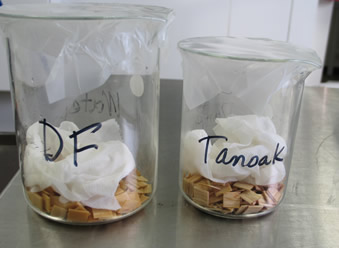Effect of Surface Sterilization Treatments on the Detection and Viability of Phytophthora ramorum on Various Substrates
Katie Coats, Kathy Riley, Gary Chastagner and Marianne Elliott, Washington State University, Puyallup Research and Extension Center, 2606 W. Pioneer, Puyallup, WA 98371; kpcoats@wsu.edu
An accurate evaluation of asymptomatic colonization of plant tissue by Phytophthora ramorum requires the ability to distinguish between the surface contamination or epiphytic growth of the pathogen and the colonization of plant tissues. Growth on selective media, such as CARP, following the surface sterilization of plant tissue is often used to confirm P. ramorum colonization of the tissue. The use of PCR to detect asymptomatic colonization of tissues requires that treatments kill pathogen propagules as well as render residual pathogen DNA on the surface of substrates undetectable. A series of surface sterilization tests were performed with two commonly used laboratory surface sterilants to determine their efficacy in killing epiphytic propagules of P. ramorum and rendering pathogen DNA undetectable in several different P. ramorum experimental scenarios. Substrates tested include detached rhododendron leaves, rhododendron leaf discs, and freshly harvested Douglas-fir wood. Whatman filter paper was included to represent an inert surface.
Results from preliminary tests indicate that the efficacy of a treatment varies by experimental scenario and detection method. Based on post-sterilization growth on CARP media, a 30-second treatment in a 10% solution of household bleach (0.6% sodium hypochlorite) one hour after a spore suspension of P. ramorum was applied to rhododendron leaves and leaf discs was as effective as higher concentrations of bleach and longer treatments in bleach in killing the pathogen on the surface of this host. When spore suspensions were placed on Douglas-fir wood samples, a 30-second treatment in a 10% solution of bleach was not as effective as a 30-second treatment with 95% ethanol, based on CARP isolation data post-treatment. When spore suspensions were placed on Whatman filter paper and incubated for 2 days, a 10% bleach solution, 95% ethanol, and water each appeared equally as effective in preventing the detection of P. ramorum by isolation on CARP media post-treatment. When post-treatment quantitative PCR was used to detect the pathogen on Whatman filter paper and Douglas-fir, 10% bleach effectively removed DNA evidence of the pathogen while 95% ethanol and water were ineffective, leaving behind DNA at quantities comparable to those on non-treated substrates.
Additional studies are in progress and will be presented at the symposium.
in
Proceedings of the Sudden Oak Death Fourth Science Symposium 2010
Susan J. Frankel, John T. Kliejunas, and Katharine M. Palmieri, tech. coords.
Gen. Tech. Rep. PSW-GTR-229. Albany, CA: U.S. Department of Agriculture, Forest Service, Pacific Southwest Research Station. 378 p
| Abstract pdf | Poster pdf |